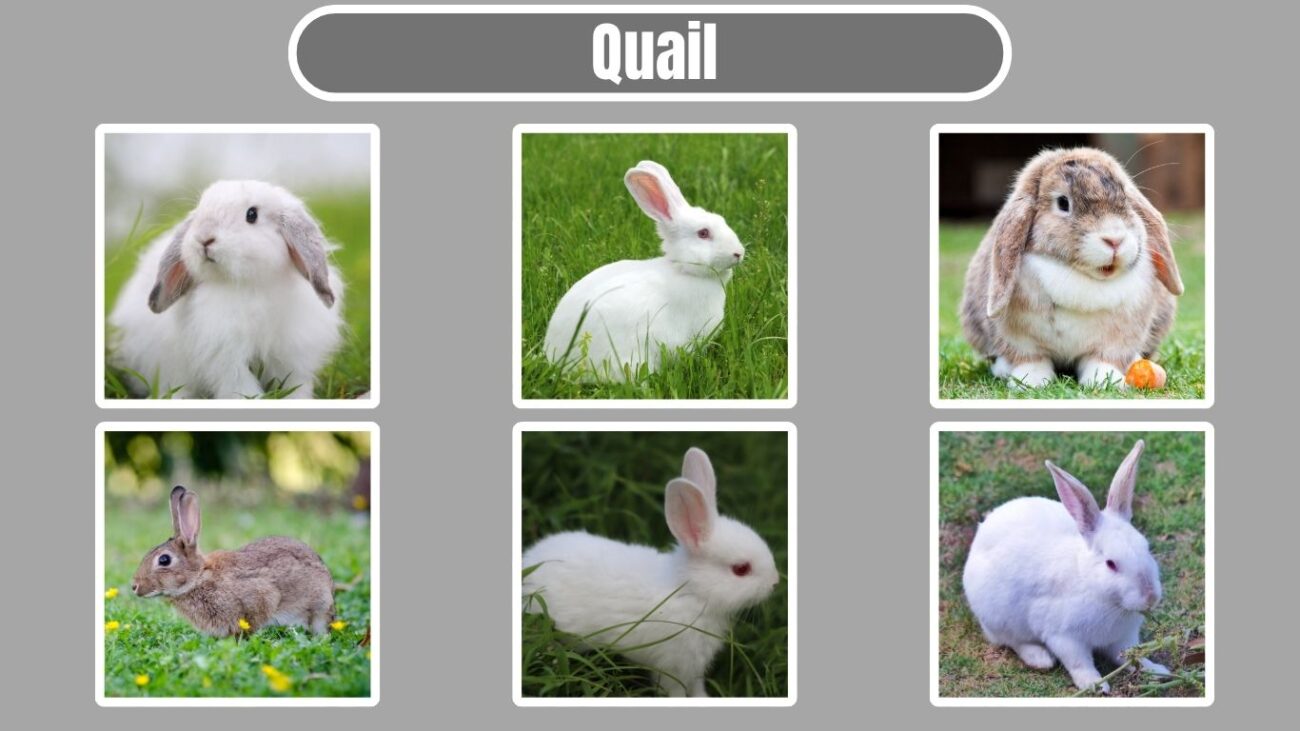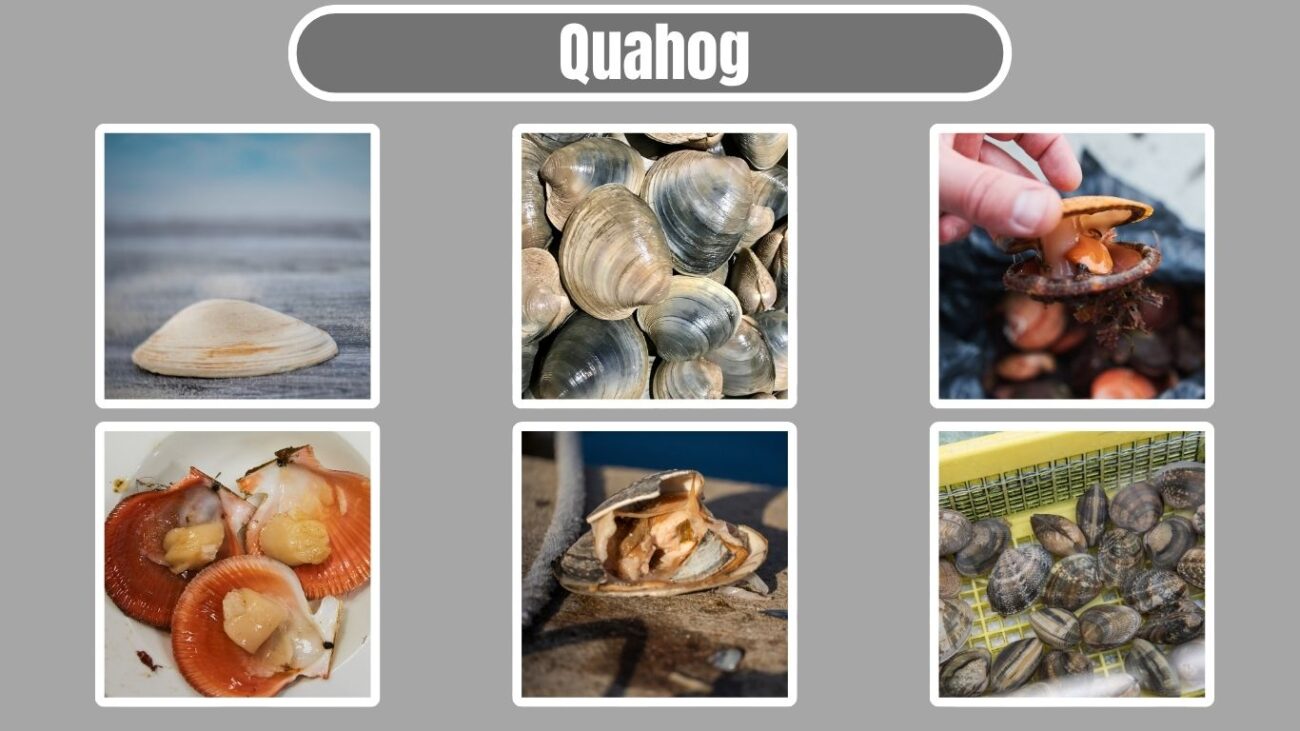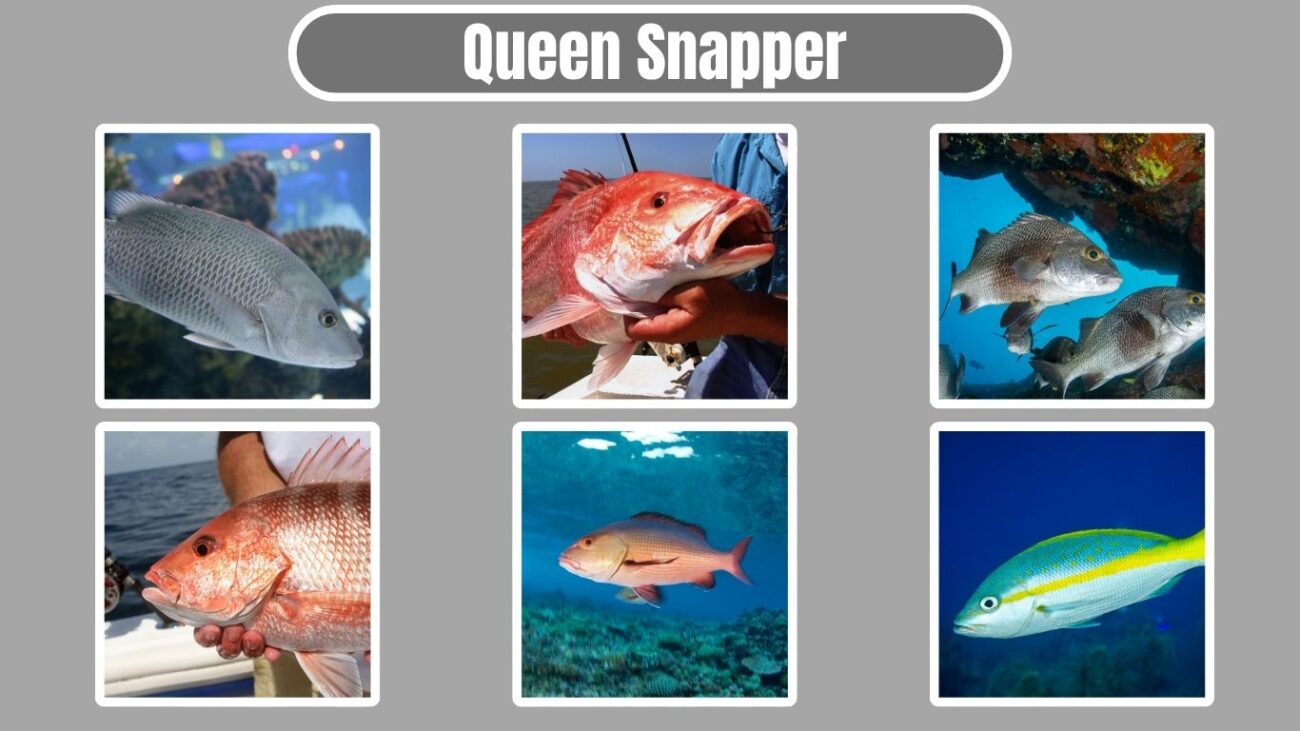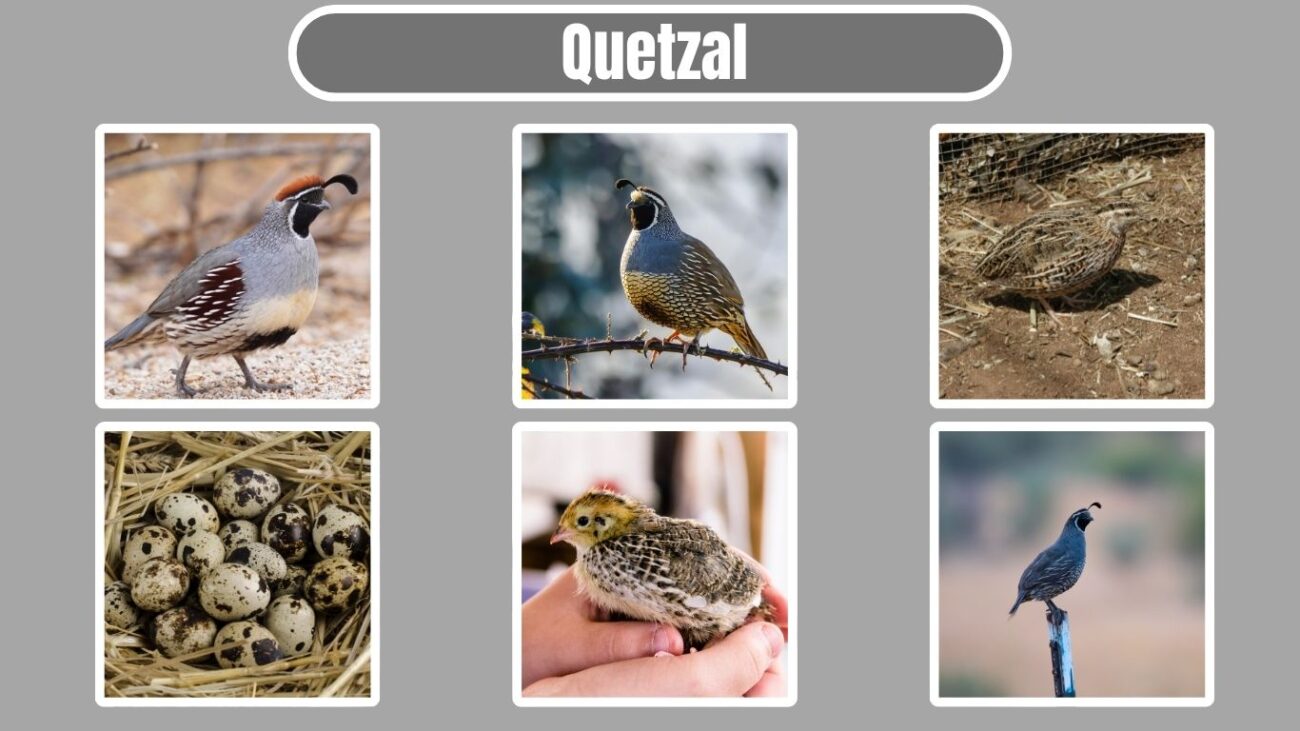Animals that start with the letter Q may not be as abundant as those from other letters, but they include some truly unique and fascinating species. From the cheerful Quokka to the mysterious Queensland Lungfish, these creatures come from all corners of the world—rainforests, oceans, deserts, and even your backyard. Many play critical roles in their ecosystems, whether it’s the Queen Bee leading a hive or the Queen Ant founding a colony.
In this list, you’ll discover 30 animals that begin with the letter Q, including mammals, birds, insects, reptiles, sea creatures, and more. While some names might be familiar, others may surprise you with their exotic appearance or incredible behaviors. Let’s dive into this rare but remarkable collection of Q-named animals.
1. Quail
Quail are small, plump birds found across North America, Europe, Asia, and Africa. They typically measure 4.5 to 7 inches (11–18 cm) in length and are known for their short tails and rounded bodies. Most quail species have earth-toned feathers with speckled or barred patterns, providing excellent camouflage in grassy habitats.
They are ground-dwelling birds that prefer open fields, meadows, and woodlands. Quails feed on seeds, grains, and insects, scratching at the ground with their feet to forage. Despite their short wings, they can fly quickly for short distances to escape predators.
Quail are also valued for their eggs and meat and are raised domestically in many parts of the world.
2. Quokka
The Quokka is a small, herbivorous marsupial native to southwestern Australia, especially on Rottnest Island. Often called “the world’s happiest animal” due to its adorable smile-like expression, the quokka is about the size of a domestic cat, measuring 16–21 inches (40–54 cm) long.
It has gray-brown fur, rounded ears, and a short tail. Quokkas are nocturnal and primarily feed on grasses, leaves, and shrubs. They are excellent climbers and live in dense vegetation, using it for shelter and nesting.
Though friendly in appearance, quokkas are protected animals, and feeding or touching them is prohibited in the wild.
3. Quoll
Quolls are carnivorous marsupials native to Australia and New Guinea. They are medium-sized animals with pointed snouts, long tails, and soft fur typically patterned with white spots on a brown or reddish body. Depending on the species, quolls range from 10 to 30 inches (25–75 cm) in body length.
They are nocturnal hunters and climb well, preying on insects, birds, frogs, and small mammals. Quolls live in forests, grasslands, and rocky areas, often using burrows or tree hollows for shelter.
Once common, quoll populations have declined due to habitat loss and invasive species, and they are now considered vulnerable or endangered.
4. Queen Angelfish
The Queen Angelfish is a vibrant, tropical reef fish found in the warm waters of the western Atlantic Ocean, especially around coral reefs in the Caribbean and Gulf of Mexico. It gets its name from the crown-like blue spot on its head and dazzling colors—electric blue, yellow, and green.
Adults can grow up to 18 inches (45 cm) long. They feed on sponges, algae, and small invertebrates, gliding gracefully through reef crevices.
Highly prized in aquariums for their beauty, queen angelfish are solitary or form monogamous pairs. In the wild, they play an important role in maintaining reef health.
5. Queen Bee
The Queen Bee is the only fertile female in a honeybee colony and the mother of most—if not all—of the hive’s bees. She is larger than worker bees, with a longer abdomen and smooth, shiny appearance.
Her main role is reproduction, laying up to 2,000 eggs per day during peak season. She also releases pheromones that regulate the behavior and development of other bees in the colony.
Queen bees live up to 3–5 years, far longer than workers. When a queen weakens, the colony will raise a new one by feeding select larvae a special diet of royal jelly.
6. Queen Butterfly
The Queen Butterfly (Danaus gilippus) is a striking orange-and-black butterfly found throughout the southern United States, Central America, and parts of South America. It closely resembles the monarch butterfly but is typically darker in color and has white spots on its forewings and body.
Adults grow with a wingspan of about 3 to 4 inches (7.5–10 cm). Like monarchs, queen butterflies feed on milkweed, which makes them toxic to predators. Their larvae are black-and-white banded caterpillars with tentacle-like appendages.
They thrive in open, sunny areas such as meadows, gardens, and grasslands, and play an important role in pollination.
7. Queen Snake
The Queen Snake is a non-venomous, slender snake native to the eastern United States. It typically measures 15 to 24 inches (38–61 cm) long, with olive to gray-brown coloring and a pale yellow or cream stripe along each side of its body.
This species lives near freshwater streams, rivers, and rocky creeks, especially where crayfish are abundant—its primary food source. Queen snakes are excellent swimmers and are most active during the day.
Though often mistaken for other harmless snakes, they are peaceful and play an important role in freshwater ecosystems.
8. Queensland Grouper
The Queensland Grouper (also known as the Giant Grouper) is one of the largest bony fish in the world, found in warm coastal waters around northern Australia, Southeast Asia, and the Indo-Pacific region. Adults can grow over 8 feet (2.5 meters) long and weigh more than 800 pounds (360 kg).
This solitary, reef-dwelling predator feeds on crustaceans, smaller fish, and even sharks. It has a large mouth, mottled gray to brown skin, and thick, powerful fins.
Once heavily overfished, it is now protected in several areas. Despite its intimidating size, the Queensland grouper is generally slow-moving and calm.
9. Queensland Heeler (Australian Cattle Dog)
The Queensland Heeler, more commonly known as the Australian Cattle Dog, is a tough, energetic herding dog breed developed in Australia. It earned the “heeler” nickname from its technique of nipping at the heels of livestock to herd them.
These medium-sized dogs have muscular builds, speckled coats (often blue or red), and erect ears. They are highly intelligent, loyal, and excellent working dogs—also popular in agility sports.
Queensland Heelers need regular exercise and mental stimulation and are best suited for active owners or farms where they can put their skills to use.
10. Queensland Lungfish
The Queensland Lungfish is a prehistoric freshwater fish found only in a few rivers in Queensland, Australia. Known as a “living fossil,” it has existed for over 100 million years and retains primitive features.
It can grow over 5 feet (1.5 meters) long and has olive-green, brown, or reddish scales. Uniquely, it has a single lung in addition to gills, allowing it to breathe air when oxygen levels in water are low.
The lungfish lives in slow-moving rivers and feeds on snails, worms, and crustaceans. It is a protected species due to its limited distribution and ancient lineage.
11. Quaker Parrot (Monk Parakeet)
The Quaker Parrot, also known as the Monk Parakeet, is a small, bright green parrot native to South America. It has a grayish face and chest, with green wings and back, and a long, pointed tail. Adult Quakers are about 11–12 inches (28–30 cm) long.
Unlike most parrots, Quaker parrots build large communal stick nests, often on utility poles or trees. They are intelligent, social, and capable of mimicking human speech, making them popular as pets.
Feral populations have established in parts of the U.S. and Europe due to escape or release, and in some regions, they are considered invasive.
12. Quahog (Hard Clam)
The Quahog is a species of edible hard clam found along the eastern coast of North America. It has a thick, rounded shell and typically measures 2–4 inches (5–10 cm) across, though some can grow much larger.
Quahogs burrow into sandy or muddy seabeds in shallow waters and filter feed by drawing in plankton and nutrients from the surrounding water. They are a popular seafood item and are often steamed, baked, or made into chowder.
These clams can live for decades—some even over 100 years—and play an important role in marine ecosystems by filtering water.
13. Quagga (Extinct Subspecies of Zebra)
The Quagga was a subspecies of the plains zebra, once found in South Africa. It was distinguished by its unique coloration—striped only on the front half of its body, with a solid brown rear and legs.
The quagga was about the size of a modern zebra, around 4.5 feet (1.3 meters) at the shoulder. It grazed on grasses and lived in herds in dry grasslands and savannas.
Sadly, quaggas were hunted to extinction in the late 19th century. The last known individual died in a zoo in 1883. Efforts are underway to revive quagga-like zebras through selective breeding.
14. Quacking Frog
The Quacking Frog is a small, ground-dwelling frog native to Western Australia. It gets its name from the distinctive quacking call the males make during mating season. Adults are usually around 1.5 inches (4 cm) long.
They have brown to olive skin with dark blotches and are well-camouflaged among leaf litter and soil. These frogs are burrowers and emerge after heavy rains to breed in temporary pools.
Their diet includes ants, small insects, and larvae. Though not widely known, the quacking frog is a resilient species adapted to dry environments.
15. Quarter Horse
The Quarter Horse is one of the most popular and versatile horse breeds in the United States. It is named for its ability to sprint a quarter mile faster than any other horse breed. Strong, muscular, and compact, Quarter Horses typically stand between 14–16 hands (56–64 inches) tall.
They come in many colors, including sorrel, bay, black, and palomino. Known for their calm temperament, intelligence, and agility, they excel in rodeo events, cattle work, and pleasure riding.
This breed is especially popular among ranchers and equestrians and is a symbol of the American West.
16. Quince Monitor (Lizard)
The Quince Monitor is a brightly colored species of monitor lizard native to Indonesia, particularly the island of Obi. It belongs to the Varanus genus and can grow up to 4 feet (1.2 meters) in length. Its striking yellow body with dark banding makes it a favorite among reptile enthusiasts.
These monitors are carnivorous, feeding on insects, small rodents, birds, and eggs. They are arboreal and semi-aquatic, often found in forested areas near water.
Though rare in the wild, they are sometimes bred in captivity. Due to their size and strong claws, they require experienced handling and large enclosures.
17. Quinkan Rock-Wallaby
The Quinkan Rock-Wallaby is a rare marsupial found only in the rocky escarpments of Queensland, Australia. It’s a small, agile creature, measuring about 18–24 inches (45–60 cm) long, with powerful hind legs and a long tail used for balance.
This wallaby has a soft gray-brown coat with lighter underparts and is well-adapted to its rugged habitat. It feeds mainly on grasses, leaves, and fruits.
Due to its limited range and threats from predators like foxes and habitat degradation, the Quinkan Rock-Wallaby is considered vulnerable and protected under Australian wildlife conservation laws.
18. Queen Snapper
The Queen Snapper is a deepwater fish species found in the western Atlantic Ocean and the Gulf of Mexico. It’s known for its vivid red to pink body and long, slender shape. Adults can reach lengths of 30–36 inches (75–90 cm).
They live at depths between 300 and 1,500 feet (90–450 meters) over rocky bottoms and slopes. Queen snappers feed on smaller fish and squid.
Due to their excellent taste, they are targeted in commercial and recreational deep-sea fishing. Their unique coloration and habitat make them a standout among snapper species.
19. Quailfinch
The Quailfinch is a small, ground-dwelling songbird found in sub-Saharan Africa. It resembles a miniature quail with finch-like features and is about 4 inches (10 cm) long. Males are marked with black throats and faces, while females have more subtle coloring.
These birds inhabit grasslands and savannas, often near water, and feed on grass seeds and insects. Quailfinches are social and are often seen in small flocks.
They are popular in aviculture due to their active behavior and pleasant chirping, though they require warm temperatures and open spaces for optimal care.
20. Quokka Rat (Informal/Obsolete Term)
The Quokka Rat is an outdated term sometimes used to refer to small macropods similar to the quokka, though it is not a scientifically recognized species today. It may have referred historically to similar wallaby-like marsupials with rat-like tails and smaller size.
These animals, like the quokka, are herbivorous and nocturnal, found primarily in southwestern Australia. They dwell in scrubby vegetation and rely on dense cover for safety from predators.
Modern taxonomy has clarified that these animals are closer to wallabies than actual rodents, and the term “quokka rat” is now largely obsolete.
21. Quoll Marsupial
Quoll Marsupials are carnivorous mammals native to Australia and New Guinea, belonging to the genus Dasyurus. While already mentioned as “quoll,” this entry highlights that there are multiple species of quolls, including the Eastern Quoll, Northern Quoll, and Spotted-Tail Quoll.
These marsupials are small to medium in size, with pointed snouts, sharp teeth, and fur patterned with distinctive white spots. They are mostly nocturnal and hunt insects, birds, and small reptiles.
Quolls play an important role in their ecosystems as predators, but their populations are threatened due to habitat loss, invasive species like cane toads, and disease.
22. Quail Dove
The Quail Dove is a group of ground-dwelling doves native to the Caribbean and Central/South America. These birds are known for their beautiful, iridescent plumage—often featuring rich browns, purples, and greens—and their shy, elusive behavior.
They are medium-sized, around 9–11 inches (23–28 cm) long, and prefer forest undergrowth, where they forage for seeds, berries, and insects.
Quail doves are rarely seen in flight and typically walk or run through dense vegetation. Species include the Ruddy Quail-Dove and the Key West Quail-Dove, both of which are important to tropical forest biodiversity.
23. Queen Triggerfish
The Queen Triggerfish is a colorful reef fish found in the tropical Atlantic Ocean and Caribbean Sea. It is known for its vivid blue, green, and yellow markings, as well as its sharp, forward-pointing dorsal spine used for defense—hence the name “triggerfish.”
Adults can grow up to 24 inches (60 cm) and are strong swimmers. They inhabit coral reefs and rocky areas, feeding on sea urchins, crustaceans, mollusks, and other invertebrates.
Though beautiful, they can be aggressive, especially during nesting season. Divers and aquarium enthusiasts admire them for their intelligence and striking appearance.
24. Quetzal
The Quetzal is a stunning bird native to Central America, especially in cloud forests of Guatemala, Costa Rica, and Panama. The most famous species, the Resplendent Quetzal, features brilliant green plumage, a red chest, and long tail feathers that can extend up to 3 feet (1 meter) in males.
Quetzals are medium-sized birds, about 14–16 inches (35–40 cm) long without the tail. They eat fruits, particularly wild avocados, as well as insects and small animals.
The quetzal is revered in Mesoamerican mythology and is the national bird of Guatemala, symbolizing freedom and beauty.
25. Quokka Wallaby (Informal Name)
The term Quokka Wallaby is sometimes informally used to describe the quokka, emphasizing its relation to the wallaby family. Though the name isn’t scientifically used, it reflects the quokka’s classification as a small macropod—a group that includes kangaroos and wallabies.
Quokkas hop similarly to wallabies and share their herbivorous diet and nocturnal behavior. They dwell in shrubland and forest undergrowth on islands and protected areas of Western Australia.
The nickname “quokka wallaby” is a friendly way to describe their cute, compact appearance and wallaby-like traits.
26. Queen Termite
The Queen Termite is the reproductive powerhouse of a termite colony. She is significantly larger than other termites, with a massively distended abdomen that can reach over 2 inches (5 cm) long. This swollen body is filled with eggs, and she can lay thousands of eggs each day.
Queen termites live deep within the nest, surrounded by workers and guarded by soldiers. Her primary role is reproduction, and she rarely moves once mature.
Depending on the species, queen termites can live up to 15–25 years, making them some of the longest-living insects. Their presence ensures the survival and growth of the entire colony.
27. Queen Scallop
The Queen Scallop (Aequipecten opercularis) is a small species of bivalve mollusk found in the northeast Atlantic Ocean, including waters around the British Isles. It has a fan-shaped, ribbed shell that comes in shades of cream, pink, orange, or brown.
Queen scallops are filter feeders, drawing in plankton from the water. They grow to about 3 inches (7.5 cm) and are capable of rapid swimming by clapping their shells together.
They’re highly valued as seafood in Europe and are often harvested by dredging or diving. These scallops are also known for their vivid shell colors and symmetrical appearance.
28. Quedius Beetle
The Quedius Beetle is a genus of rove beetles found across Europe and North America. These beetles are typically small to medium-sized, measuring between 4–12 mm, with a glossy black or dark brown body and short elytra (wing covers).
They are often found in decaying organic matter, under bark, or in compost, where they feed on other insects, larvae, and mites. This makes them beneficial in gardens and natural ecosystems as natural pest controllers.
Although not well-known to the public, Quedius beetles play an important ecological role in decomposition and predation of small pests.
29. Queen Ant
The Queen Ant is the sole fertile female in most ant colonies, responsible for laying all the eggs that sustain the colony. She is larger than the worker ants, often with wings early in life, which she uses during the mating flight.
Once mated, she sheds her wings and starts a new colony, laying thousands to millions of eggs over her lifetime. Some queen ants can live for decades, depending on the species.
She is usually cared for by worker ants and rarely leaves the nest again. Her health and productivity determine the colony’s success and longevity.
30. Queensland Tube-nosed Bat
The Queensland Tube-nosed Bat (Nyctimene robinsoni) is a rare fruit bat found in northeastern Queensland, Australia. Its most distinctive feature is its tube-shaped nostrils, which project outward from its snout—an adaptation believed to aid in scent detection.
This bat has a wingspan of about 12 inches (30 cm) and mottled, pale brown or olive fur. It inhabits rainforests and feeds primarily on fruit, playing a key role in seed dispersal.
Though not often seen, it is an important part of Australia’s tropical ecosystems and is protected under regional conservation laws.






